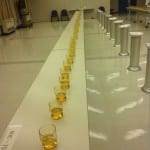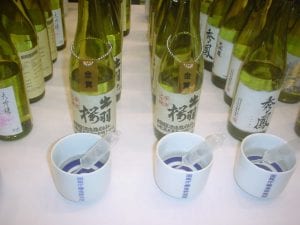…and live to tell about it
 Some things are not what they seem. That kind of defines sake brewing, and much about the sake world in general. One poignant example of that is judging in sake tastings, as many people imagine that it is a ton of fun. “How cool! Tasting sake for a living! What a great job!”
Some things are not what they seem. That kind of defines sake brewing, and much about the sake world in general. One poignant example of that is judging in sake tastings, as many people imagine that it is a ton of fun. “How cool! Tasting sake for a living! What a great job!”
In truth, there are, in fact, worse jobs. So, it does not totally suck. And I only do it several times a year, so it is hardly a “job.” But really, it is anything but fun.
Of course the first few dozen are cool, fun, and enjoyable. But very few tastings in the sake world consist of only a few dozen sake. More often than not, especially at proper government or industry tastings in which proper and strict scoring is called for, there are about ten times that many. And the judges of course have a responsibility to assess each one carefully, properly and to the best of their ability.
There are many ways of competitively tasting alcoholic beverages. Most tasting competitions have panels that are groups of half a dozen tasters with an experienced leader. If there is less than a clear majority or consensus on any one sample , discussion ensues to round that out up, and that process takes time. Scores are often on a 100-point scale, even if the lower 70 percent of that is never used.
Tasting sake in Japan has always been done a bit differently. Judges work alone, at their own pace, with no discussion with other judges. Scoring is typically 1 to 5, with 1 usually being the best. Judges can work at their own pace, but have to get through all the sake. It gets monotonous: taste, spit, score, move on. Again. Again. Again.
But, really, this is just one more way of doing it. Although it certainly does not need to be this way, it does allow lots of tasters to work through a large number or sake. In fact, one can easily judge several hundred sake in a day in tastings in Japan. Over 25 years of participating in tastings like this, I would say that the typical maximum is 220 or thereabouts.
However, I have done up to 550 in one day. Five. Hundred. And fifty. It was in a tasting held by a distributor in Tokyo, and I participate every year (although the event was cancelled this year for obvious reasons.)
How does one taste 550 sake in one day? One at a time; that’s how.
Obviously, the fun factor wears off pretty quickly. But the hardest part about it is maintaining focus and concentration. Sure, palate  fatigue comes into play as well, but more than that it’s mental. And, while of course each sake is assiduously expectorated, after 100 or so the inevitable buzz that you actually do not want rears its ugly head. It’s definitely a long-ass day. What can you do to make it easier on yourself? Several things, in fact.
fatigue comes into play as well, but more than that it’s mental. And, while of course each sake is assiduously expectorated, after 100 or so the inevitable buzz that you actually do not want rears its ugly head. It’s definitely a long-ass day. What can you do to make it easier on yourself? Several things, in fact.
Breakfast is key. To taste like that on an empty sake is just plain stupid. Still, a huge meal before tasting would dullen your senses, but if too little is eaten the buzz wins, the taster loses. Next, consciously minimize what you take in, and be sure it is consistent in volume. There is no need to take in any more than is necessary to thoroughly assess the sake, and because it is absorbed through the tongue, minimizing that helps.
Obviously frequent breaks for deep breaths and water are essential both mentally and physically. You have to remain focused through the inescapable fog. Also, after a while, a thertain numbneth theth into the tongue. Water, vigorously swished, will usually clear that out.
In one tasting in which I judged years ago for Fukushima Prefecture, they had a unique way of keeping the judges’ palates fresh. On a table in front of a chalkboard, laid out neatly, were a pitcher of water and requisite glasses, two dishes of white powder, and (get this) a bowl of eggs. It didn’t take a genius to figure out this was the palate cleansing station.
 The powders proved to be salt and baking soda, and were quite effective in helping my tongue forget temporarily the barrage of ambrosia to which it had just been exposed. The eggs, however, were new to me, and I had to ask how to use them. The egg is cracked, the yolk is manually separated from the white, swished around the palate and swallowed – raw. Of all the options available, this was (surprisingly) the most effective in absolving the taste buds of any previous experience.
The powders proved to be salt and baking soda, and were quite effective in helping my tongue forget temporarily the barrage of ambrosia to which it had just been exposed. The eggs, however, were new to me, and I had to ask how to use them. The egg is cracked, the yolk is manually separated from the white, swished around the palate and swallowed – raw. Of all the options available, this was (surprisingly) the most effective in absolving the taste buds of any previous experience.
The above will help, but nevertheless tasting that much always takes its toll. Don’t plan anything later in the day. While this seems obvious, some people are ambitious – often judges will go grab a beer after tasting that much.
So, yeah, write off the rest of the day, and the first half of the next one as well.
In truth, tastings of that scale are rare. This example is extreme; most people judging will never have to taste that much. Should you ever find yourself a judge in a sake tasting, the above should help you maintain perspective and focus.
~~~~~~~~~~~~~~~~~~~~~~~~~~~~~~~~~~~~~~
 Know more. Appreciate more.
Know more. Appreciate more.
Interested in learning more about sake, and the industry in Japan that makes it? Subscribe to Sake Industry News, a twice-monthly newsletter covering news from within the sake industry in Japan. Learn more and read a few sample issues here.





